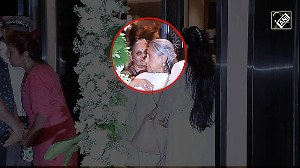When Disneyland came to Hong Kong some months ago, it needed to walk a tightrope. On one side was the in-your-face slice of Americana; on the other, the delicate and conservative Chinese fabric from which it would draw its main clientele. How, then, was it to market itself?
Among the 'concessions' made to the Chinese market was the kind of food served at restaurants within the resort. 'Traditional Chinese delicacies' was the mandate. In one menu, that translated into, well, shark fin soup. A major faux pas, needless to say. The environmentalists were angry, the local press smirked, and everyone was generally irked before the dish was put back where it belonged -- the dustbin of culinary history.
As I stroll into the spanking new $ 70 million Shangri-La that has come up in place of the erstwhile Kanishka hotel in New Delhi, to check out their new signature restaurant, it is with errant thoughts such as these. Why? I can't say. The restaurant, a pan-Asian affair, 'three restaurants in one,' as the hotel says, looks set to offer a feast.
After all, this is to be a showcase for one of the Hong Kong-based chain's core competencies. Besides, a heavyweight food writer, eating her way through a Rs 7,500 meal, has given a huge thumbs up to the restaurant.
But will 19 Oriental Avenue -- "19, because it is 19, Ashok Road" -- live up to expectations? Redefine 'Oriental' dining? Or, like the Disney restaurant, lose its way, meandering between cultures, trying to serve the authentic while wooing the local?
The restaurant itself is good-looking, subtle and modern, with three distinct sections serving Chinese, Thai and Japanese. Large open kitchens mark out these spaces and while there's one common menu, the 'restaurants' are distinct with different crockery and furnishings -- unlike, say, at the Mariott's Pan Asian, which was conceived along similar lines.
The Thai kitchen faces the entrance and our first sight (apart from shelves full of Buddha heads) is chef Yong Yos Chimthet peeling a papaya. We've been told that the chef from Bangkok turns out a fabulous raw papaya salad. But, today, he seems less than happy with what he has. "Not raw," he mutters under his breath, as we cross off one dish from that afternoon's meal.
Chinese chef James from Singapore, on the other hand, is eager and earnest: "Tell me if you find anything is wrong," he repeats.
In his kitchen -- displaying duck, rather like tandoori chicken elsewhere -- things are mostly right. The Peking duck wraps are fabulous as is the honeyed pork. If the latter is something you hardly ever find on Indian-Chinese menus, fried pigeon is something you never will.
The bird works well enough in China but not in India, as executive chef Thomas Figovc has found out. It is to be dropped from the menu soon. And though Figovc vouches that chefs have been instructed to do their stuff "as is traditionally," there are going to be other concessions to Indian sensibilities. Sweet corn soup, for instance, will be making a debut.
"Everyone asks for it," Figovc shrugs, a little disapprovingly. But not all Indian diners are unsophisticated. Steamed whole pomfret is one of the top-sellers, something the chefs didn't expect. "Last Saturday, I sold seven... I order just 10 for the whole week," Figovc adds.
The mainstay of any Asian cuisine restaurant is and should be seafood. So it is at 19 Oriental Avenue, and this is where it is likely to score over rivals. Luckily, seafood is also trend-of-the-moment in Delhi. So, even though eel and squid don't find too many brave takers, fish is doing well.
The teppanyaki salmon I tried, was definitely the lunch's highlight. The Japanese kitchen is headed by sushi chef Hashimoto and his offerings are at par with (though not better than) the best in Delhi. The selection is extensive and the chef does varieties like hand-pressed sushi. Much of the menu has been devoted to Japanese cuisine and sushi-sashimi-teppanyaki apart, you also have a yakitori grill and a bento box.
The biggest problem with the restaurant is going to be in the smattering of Chinese and Thai on the menu. Frankly -- and despite Figovc's (rather apologetic) reading that Delhi offers the "least authenticity" -- we are used to a far more sophisticated and elaborate repertoire than 19 Oriental Avenue offers.
Trying to club together three distinct cuisines obviously has its limitations -- and dangers. For one, you are forced to make do with just a handful of 'popular' dishes from each cuisine -- a vegetable sweet and sour, for instance, even done intelligently like it is here -- which do nothing for a diner in search for an experience that is exceptional or new.
Besides, if even one of these dishes go wrong, there's the threat of it colouring the entire experience. For me, the Thai kitchen ruined it all. The red curry I ordered came all wrong because the chef has apparently been told that 'Indians like thick curry.'
That evoked a sense of deja vu -- of all those times when chefs from Italy or wherever, all talented, all brought in to 'authenticate' the cuisine, had failed miserably because someone somewhere had told them that al dente was 'kachcha' and Indians liked their pasta overcooked. Not true. But, then, no one said walking the tightrope between the pop appeal and honest cooking was going to be easy.







 © 2025
© 2025